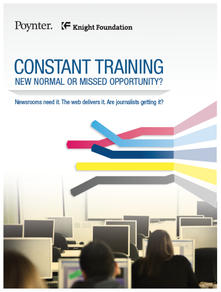ST. PETERSBURG, Fla. (Nov. 19, 2014)— Even in the fast-changing digital age, a survey of 1,118 newspaper journalists conducted by The Poynter Institute with support from the John S. and James L. Knight Foundation shows that training varies wildly between newsrooms.

Related Link
“Constant Training: New Normal or Missed Opportunity?” by The Poynter Institute
“Why I’m worried about newsroom training” by Eric Newton on Knight Blog (11/19/2014)
The report “Constant Training: New Normal or Missed Opportunity?” was based on an online survey Poynter fielded in July of 31 newsrooms nationwide ranging in staff size from 20 to 150.
Overall, roughly two-thirds of the journalists surveyed they have received training in the past 12 months. The leading category of training was social media.
A full 88 percent of the journalists surveyed said they are able to absorb more training. The most desired form of training? Social media, followed by digital tools and video skills.
The percentage of journalists reporting training in the past 12 months varied greatly from newsroom to newsroom. In one, only 17 percent of the journalists said they’d had training in the past year; in two others, it was 100 percent.
“The wide variance between newsrooms is puzzling because of the abundance of free or low-cost training,” said Howard Finberg, the report’s author and Poynter’s director of training partnerships and alliances. “Newsrooms making the digital transition need to train constantly. But even if they don’t, journalists who want to keep up have to take responsibility to learn on their own.”
Most of the journalists were satisfied with the training they did get. In fact, those getting training often wanted more. For example, 59 percent of the journalists who participated in digital tools training wanted more training on that topic. Reflecting today’s ever-changing digital environment, demand additional training was high among those who had received training in Web analytics, data journalism and blog or Web writing.
Demand also outran supply for storytelling skills. Sixteen percent of the journalists surveyed said they had writing training; 29 percent want it. Six percent got investigative reporting training; 23 percent want it. But the largest gaps between training and desire came for the topics of managing change (6 percent had it; 27 percent want it), and audience development (10 percent had it, 29 percent want it).
Lack of time was cited by 62 percent of the participants as the driving factor in preventing them from getting the training they needed or wanted. In addition, one in five of the journalists surveyed said their supervisors were not supportive or only slightly supportive of training.
Significantly, most journalists surveyed still viewed their newsrooms either as print-dominant or straddling the fence between digital and print. Only one in 10 saw their newsrooms as thoroughly “digital-first.”
“Over the decades, newsroom training has gone from an add-on frill to a survival skill,” said Eric Newton, senior adviser to the president at the Knight Foundation and author of the report’s foreword. “Journalists and newsrooms that can’t reinvent training in the digital age will face, at best, a bleak future.”
“Constant Training: New Normal or Missed Opportunity?” report and the survey data set is available at http://poy.nu/newsroomtrain2014
About The Poynter Institute
The Poynter Institute for Media Studies is an international leader in journalism education and a strategy center that stands for uncompromising excellence in journalism, media and 21st century public discourse. Poynter faculty teach seminars and workshops at the Institute in St. Petersburg, Fla., and at conferences and organizational sites around the world. Its e-learning division, News University, www.newsu.org, offers the world’s largest online journalism curriculum in six languages, with more than 400 interactive courses and 300,000 registered users in more than 200 countries. The Institute’s website, www.poynter.org, produces 24-hour coverage of news about media, ethics, technology, the business of news and the trends that currently define and redefine journalism news reporting. The world’s top journalists and media innovators come to Poynter to learn and teach new generations of reporters, storytellers, media inventors, designers, visual journalists, documentarians and broadcast producers, and to build public awareness about journalism, media, the First Amendment and protected discourse that serves democracy and the public good.
About the John S. and James L. Knight Foundation
Knight Foundation supports transformational ideas that promote quality journalism, advance media innovation, engage communities and foster the arts. We believe that democracy thrives when people and communities are informed and engaged. For more, visit, www.KnightFoundation.org.
CONTACT
Howard Finberg, Director of Training Partnerships and Alliances, The Poynter Institute, [email protected], 727-553-4371 (office), 727-642-3209 (cell)
